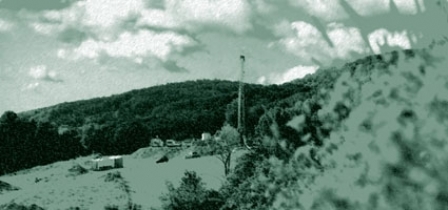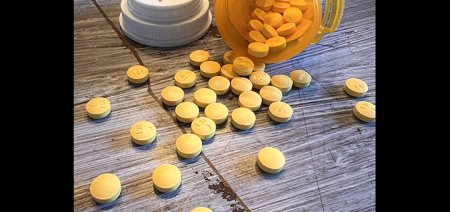Natural Gas Option: What Do We Stand To Gain, What Do We Stand To Lose?
Published:
February 17th, 2010

By Susana Schwartz
Guest Columnist
Some believe natural gas in Marcellus Shale is Central New York’s most valuable resource; others believe it’s the purity of Central New York’s water. Are the two mutually exclusive, or can the extraction of one resource leave the other unscathed?
The debate about hydrofracturing (“fracking) for natural gas has in some places pitted neighbor against neighbor: landowners who want a chance to make royalties contend they have a right to do what they want with their land, while others argue the risks to local rivers, lakes, and underground sources of drinking water - as well as soil, air and road infrastructure - make it a public, not private issue.
Hydrofracturing (a.k.a., ‘Fracking’) Below and Above the Surface
High-volume hydraulic fracturing is the drilling of a horizontal well, which becomes the access point through which high volumes of water, sand and chemicals travel to smash open rock, create fissures and allow access to natural gas deposits. Up to now, the drilling in the Central New York region has involved vertical wells in sandstones and shales like Herkimer and Utica. Because the techniques and technologies involved in hydrofracturing of horizontal wells have never been used in high volumes in New York State, it has become a contentious issue both for economic and environmental reasons. Below, we look first at economics and then second at environmental concerns.
Economics
On one side of the equation there exists the potential to generate billions of dollars in revenue, which could slow the hemorrhaging that currently characterizes New York’s budget woes, as well as to rejuvenate economically depressed areas of the state. On the other side of the equation is New York’s desire to protect its water supplies, air quality, and potential for tourism and agricultural growth from the risks of industrial hazards.
Proponents of hyrdrofracturing horizontal wells argue that the economic benefits for New York State, its municipalities and its landowners who wish to drill outweigh the risks. If Governor Patterson, for instance, imposes the three-percent “severance tax” he wants on gas removed using horizontal drilling, it could mean an extra $1 million in revenue for New York in the 2011/2012 time frame. In a state with a $134 billion budget, that may seem like a pittance, but drilling proponents point to Pennsylvania and other states as examples of how lucrative the process can ultimately be for the Empire State.
For example, John Conrad, senior hydrogeologist and president of Conrad Geoscience Corp., noted during a debate at the Linda Theater in Albany that Pennsylvania’s natural gas drilling brought $3.8 billion into that state’s economy in 2009, as well as $400 million brought in for state and local taxes in that same time frame. He also noted that New York uses more natural gas than 46 other states. Most of that natural gas is imported from North America, mainly Canada.
“Producing natural gas locally will be very lucrative in terms of income for landowners and for the state in terms of taxes,” says Brad Gill, director of the Independent Oil and Gas Association. “Based on the size of the Marcellus shale, it’s feasible that one well could possibly generate $5 million in revenue, which means 20 percent of that can mean $1 million based on what we see in terms of production [a possible 2000 Mcf per day] for 325 producing days per year.”
Despite the potential windfall of revenue for individual landowners holding leases and for the state, many people contend that the costs to towns and municipalities have to be examined more closely to truly understand the costs benefits and liabilities of drilling. Currently, natural gas is taxed in the real-property system, which means there is no production or severance tax. This has started to heat up as a debate among local municipalities and state governments.
“Based on the amount of production and the taxes the county says will be paid, about 1.7 percent of estimated revenues from natural gas wholesale sales were going to be paid out in 2010 on about $5 million worth of natural gas from Lebanon [including county, town, school district and special districts],” says Jim Goldstein, supervisor for the town of Lebanon. Based on that estimate, Lebanon will get an estimated .3 to .5 percent, which amounts to approximately $16,000.
While that sounds significant for a town the size of Lebanon, Goldstein contends it is “grossly inadequate” to compensate for the impact on Lebanon’s roads and infrastructure. Lebanon incurred approximately $550,000 in road impacts over the last two years (55 wells drilled, and another 30 in various stages of development). “The local road repair budget is about $64,000, which meant trying to fix these roads as a town would set our road repair plan back a decade and require a tax increase of approximately 111 percent.”
Goldstein has thus set up contracts to ensure gas and oil companies reimburse the town for damages to the roads. He urges municipalities in similar positions to set up agreements with gas and oil companies that allow local road superintendents to closely monitor road conditions before and after drilling activity to ensure the towns are reimbursed for damages.
Some municipalities are pushing for higher taxes on the gas and oil companies. “For example, a fuel production tax of just 2.5 percent locally would allow the town to generate an additional $107,500, which would lower town property taxes 22 percent,” says Goldstein, who believes the state should create an ombudsman oversight program to deal with oversight issues for the DEC. “With such a program, New York could raise the price of drilling permit fees and fines to pay for this oversight, which would be better than what happens now. There is no need for New York State to steal local revenues, where the impact is felt the most through a state severance tax.”
Environment
Regardless of the potential monies that could be procured by municipalities and the state as a whole, opponents to hydrofracking say there are impacts to these towns that no amount of money can reverse. For example, during the recent protests in Albany, residents of Dimock, PA talked about recent wastewater spills by Cabot Oil and Gas, which contaminated 13 wells in Susquehanna County. Though Cabot must pay $120,000 in civil penalties to the Pennsylvania Department of Environmental Protection (DEP) for violations in casing wells that led to drinking water contamination, residents say nothing can replace the drinking water and property values they have lost.
Fracking processes require approximately 3.5 million gallons of water for each instance of hydrofracturing. There is opposition because of the enormous quantities of water and questions about whether the DEC is really staffed adequately to monitor withdrawal from rivers, streams and other water sources, as well as to monitor the storage of flowback and constant hauling of contaminated water by thousands of trucks over local roads to faraway treatment facilities. Currently, there exists about 20 officers involved with natural gas drilling, but the DEC is seeking funds to increase the number of officers.
Pro-drilling landowners and drilling proponents believe New York’s environmental laws are much stronger than those in Pennsylvania, Colorado, Wyoming and other states investigating concerns around contaminated water.
“Much of what you hear about water that ignites and contamination are due to biological processes that sometimes cause methane to leak into water supplies. It has nothing to do with fracking fluid,” says Steve Palmatier, an independent consultant on natural gas issues and in the manufacturing engineering field. He says the “isolated” incidents are statistically insignificant since more than 450,000 wells safely produce gas in the United States. Palmatier also defends construction practices, noting that fracking fluids are trapped in layers of steel and concrete.
Bruce Selleck, H.O. Whitnall Professor of Geology, Colgate University, contends that the process of hydrofracking itself is pretty safe in New York compared to other states, as the process here occurs below thousands of feet of rock. However, he is concerned about the potential for surface contamination: “New York’s Marcellus and Utica Shale lie at depths greater than 1,500 feet below the surface, which means it is almost impossible for chemicals to migrate upward into drinking water aquifers because there is 1,000 feet or more of rock between the fractured shale and surface water supplies.” To Selleck, the greater concern is what happens at the surface once contaminated water from fracking is collected, stored and transported for disposal. He and others agree that without “boom-to-bust” management of the entire process, there could be a chance for chemicals to end up in water supplies some day, especially as wells age or cement and steel infrastructure breaks down.
“Toxic chemicals undergo chemical changes when fracking, and we have to wonder what will happen as these chemicals react and as infrastructure breaks down over the period of many years,” says Ron Bishop, a Ph.D. in biochemistry and chemical hygiene officer whose focus is managing chemical, biological, radiation and physical and compressed gases. He points to EPA findings that show some of the fracking chemicals are harmful to humans, and lethal to certain species, even at concentrations “below detection levels.” According to Bishop, that means “you don’t know the impact until species in the ecosystem start dying.”
Indeed, there have been chemicals deemed “safe” in the past that are now known to be dangerous. “For example, hydrogen sulfide was once thought to be safe, until fertility rates in livestock dropped 20 percent in British Columbia. Now when it is discovered in the drilling process, geologists on site make adjustments to the fracking compounds to counteract the impact of the chemical,” explains Bishop. “How much potential harm do we not know about yet?”
He says a chemical known as DBNPA, sometimes used in fracking, came up for re-registration with the EPA, and was found to be very toxic to three aquatic organisms, including brown trout, Chesapeake Bay Oysters and water fleas (daphnia magna, a major food source). Also, 2BE (2ButoxyEthanol), which also went through re-registration recently, is a “glycol ether” commonly used in fracking and household products. “In very small concentrations [close to no detection], it has been shown to decrease fertility in humans and livestock, as well as increase birth defects and adrenal tumors,” says Bishop. He says there are studies that show people working in natural gas purification plants in western states have spikes in birth defects and adrenal tumors. “You have to pay attention, as it’s usually rare for there to be adrenal tumors,” says Bishop.
4-Nitroquinoline 1-oxide - one of the most hazardous substances ever made - is a chemical that is generating a lot of controversy. Robert Howarth, a David R. Atkinson Professor of Ecology & Environmental Biology at Cornell University, has noted publicly that enormous amounts of this chemical could come up at every well - much of which will be “stored” at the surface, thus posing a threat to humans and animals if it evaporates or gets into water supplies.
In New York, it is expected that the DEC will demand open brine pits give way to a practice of storing fracking fluids in closed storage units. But some say the risk of spillage is too great. Some citizens say it is better to wait until nitrogen and propane could be used for extracting gas from rock formations.
With all the noise around carcinogenic materials like Benzene and Formaldehyde, which are injected into wells for fracking, gas industry sources, such as Palmatier and Gill, assure that the “unspecified substances” used in fracking are the same as those commonly used household products, such as shampoo, friction reducers like that used in contact lenses, and biocide disinfectants used in swimming pools. According to the DEC, these chemicals make up about 0.05 percent of the fracking mixture.
Palmatier also points out that the DEC will put mechanisms in place to test water before and after drilling through pre- and post-drilling requirements. “Criticisms about possible environmental harm, chemical additives, lax regulations are often distortions that create fear,” he says. “Despite misgivings, the composition of the fracking fluid is well known by the DEC, which has full visibility into the formulations used for fracking fluid, and full authority and ability to regulate drilling activities.” Palmatier adds, “The composition of fracking fluids also is revealed to any sewage treatment plant operator that treats the effluent.”
Even though the DEC and sewage treatment operators are cognizant of the chemicals used in fracking cocktails, there remains distrust around management of the full lifecycle of the wells.
“It is important that there be management of wells in their older stages or of wells that are ‘abandoned’ or ‘shut in’ to ensure the subsurface is isolated from the near surface,” says Selleck, noting that developers are required to provide monies for long-term management.
IOGA’s Gill assures that the DEC has safeguards in place: “We pay ‘plugging bonds’ to guarantee the wells are plugged, and to ensure we into orphaned wells. The DEC keeps records on which wells have to be plugged.”
Landowners and denizens concerned about the future are pushing the DEC and EPA to consider the complete cycle. Both the state and federal agencies are evaluating hyrdrofracturing fluids technology and its impact on underground fissures, fossil fuel reservoirs and water supplies above and below the ground. Water tests and monitoring wells are currently being dug by the EPA in such states as Wyoming, Colorado and Pennsylvania, but results are not expected for months.
Additionally, New York and other states are looking at changes in exemptions implemented in the 2005 National Energy Policy Act, which has caused controversy about whether fracking fluids fall under the purview of the Underground Injection Control (which protects underground sources of drinking water from contamination by underground injection of hazardous and non-hazardous fluids). As a result of these debates, the “Fracking Responsibility and Awareness of Chemicals Act,” [FRAC ACT] sits in the House, and a companion bill sits in the Senate.
There is also pressure to review compulsory integration, the practice whereby acreage deemed by a gas company to be in a “spacing unit” can be forcibly “integrated” if 60 percent of landowners in that “unit” voluntarily lease their properties. Integration as a non-participating owner opens questions about water contamination, and whether the landowner is responsible for the same things as a participating owner.
Guest column by Susana Schwartz, a freelance high-tech writer.
Comments





